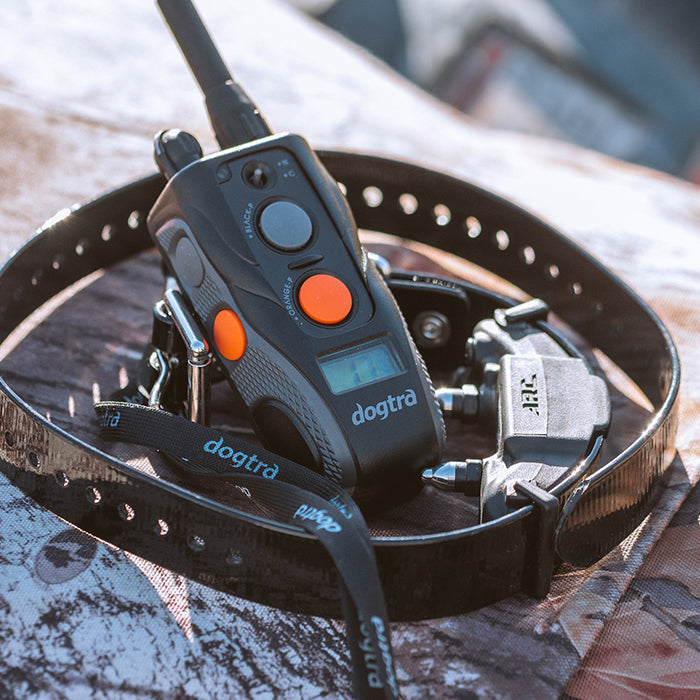HOW TO MAKE YOUR DOG LISTEN: 4 TIPS FOR COLLAR-WISE DOGS

The term “collar wise” are dirty words in the training industry. Collar wise is used to reference a dog whose demeanor and behavior changes once the e-collar is on. A dog who listens when the collar is on and doesn’t when the collar is off.
Most often, the term is applied to e-collars, but the truth is a dog can become discerning about any collar or training tool. There are certainly plenty of dogs that alter their behavior based on a head halter, prong collar, or leash being on or off. And there are just as many dogs that won’t respond if a treat is not in the owner's hand. Keep reading to learn more about how to make your dog listen.
Do E-Collars Make Your Dog Collar-Wise?
Good training practices involve building a strong and reliable relationship. Therefore, any long-term dependency on a training tool should be frowned upon. For some reason, though, the e-collar gets more than its fair share of disparaging commentary when it comes to collar-wise theories.
The bottom line in any discussion about tool dependency is that at some point, the trainer either lacked knowledge about how to progress or just got careless in doing the work. A tool is only as useful as the handler’s knowledge of how to apply it.
Common Mistakes that Lead to Collar Dependency in Dogs
For the sake of discussing e-collars specifically, let's take a look at common mistakes that can lead to dependency on the equipment:
-
Only putting the collar on the dog during a “training session”
-
Reaching for or going to find the e-collar transmitter to enforce a command rather than being ready in the moment.
-
Giving a command and not following through with enforcement if the dog does not comply.
There is a long-held saying in the training world that you should “Never give a command that you can’t enforce.” It is sound advice.
How to Make Your Dog Listen During Training With E-Collar
Sometimes we can’t enforce because we’ve gotten into a situation without thinking ahead about the potential consequences, and sometimes we simply don’t enforce because we’re too tired or frustrated to follow through. Both of those situations are on us, though, and not a fault of the equipment…so it might be more appropriate to say that our dogs become enforcement-wise due to our lack of knowledge and consistency.
Follow these tips to prevent your dog from becoming dependent on the e-collar (or any equipment for that matter):
1. Have Your Dog Wear the E-Collar Routinely
If your dog is wearing the collar during training AND playtime, feeding time, resting, etc., it will not become associated only with enforcement.
2. Be Discreet in Your Use of the Equipment
Don’t point the transmitter at your dog, or keep it hanging around your neck where reaching for it becomes a clear signal to your dog that follow-through is about to occur. Instead, vary how you use the transmitter. Keep it in hand when training, in a pocket when out and about playing, and clipped on your waist when around the house. If the location varies and your use of the transmitter is discreet, it is more difficult for your dog to cue on obvious signals. Plus, having the transmitter actually on you when the dog is wearing the e-collar, will mean you are actually ready to follow through if the need arises.
3. If You Start Without the E-Collar, Finish Without the E-Collar
By that, I mean if the transmitter is not on you and your dog does not comply with what you have asked, don’t go and get the transmitter to enforce your command. The timing will be too late, and dependency on the e-collar too obvious. Make your dog follow through by using other means. This might mean you have to walk down a dog who is 150 yards out in the field, it might mean using some spatial pressure or the leash to influence or simply touching the rear end to manipulate into a sit…but follow through so the relationship becomes about you and your dog, not about the equipment.
4. Let the Dog Know What He Is Doing Right
Too often, we focus only on correcting the mistakes and don’t put enough emphasis on what the dog does correctly. Remember that dogs will repeat behaviors that are rewarding, so make sure you are demonstrating to your dog that doing as you ask pays off in a variety of good dividends. Food, toys, play, praise, or simply permission to chase the squirrel because you said it was OK are all ways you can demonstrate to your dog that good things will happen when he pays attention and listens to you.
Conclusion
The e-collar is a fantastic tool, but like any other, it takes knowledge to use it well. If you’re finding a problem with your dog’s reliability being dependent on wearing the equipment or not, then it is probably time to grow your knowledge and skills.
A well-trained dog is one that has built a relationship based on conditioning and consistency that evolves into reliable habits.




